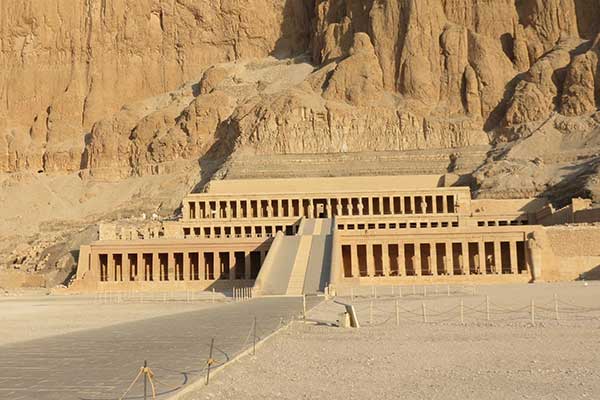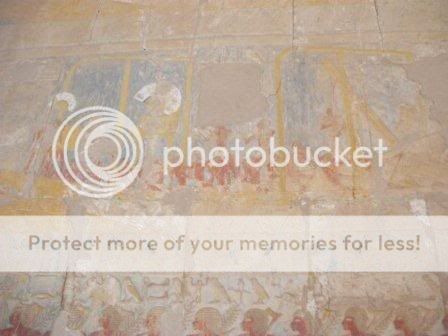A thousand shades of sandy-brown. Only two miles from the Nile and all hint of green is gone. It is easy to see why the ancient Egyptians called the desiccated ground either side of their narrow fertile strip the Red Lands, from which our word ‘desert’ is said to derive. And since the sun set in the west the western desert was the land of the dead. Here, on the opposite side of the Niles from the great cities lie complexes of tombs and mortuary temples, none more spectacular than the mortuary temple of Hatshepsut, the Pharaoh Queen.
View of the mortuary temple complex
Hatshepsut was one of the few female pharaohs, reigning for about 21 years up to 1458 BC, in the period of ancient Egypt known as the New Kingdom, the time when the Egyptian Empire grew to its greatest extent. A daughter of the old pharaoh Thutmose I by one of his main wives, she married one of her half brothers as his main wife, bolstering his claim to the throne (he was the son of the pharaoh by a minor wife). Her husband / half brother became Thutmose II but he soon died and his son by a lesser wife became the official pharaoh, Thutmose III, with his Hatshepsut as regent because he was still a child.
Hatshepsut seems to have become rather fond of power and soon styled herself pharaoh instead, holding onto the throne even when her son reached the age of majority. Apart from being one of the few female pharaohs, she is famous for sending a large trade expedition to the ‘Land of Punt,’ which brought back many different exotic goods, illustrated on the walls of the temple.
The inscriptions from her time aren’t detailed enough to say for definite where Punt was, but leading contenders are Somalia and Ethiopia, with Arabia as another possibility. What is definite is that during her time Egypt was rich and well connected in trade. Wall paintings of piles of goods make it clear what a variety there was to be had for those with the wealth.
Wall painting from the temple of piles of grave goods
Hatshepsut’s mortuary temple nestles at the bottom of the cliffs that separate the Nile valley from the high desert plateau beyond. It is built in a series of layers, each a large open square, leading up to the main buildings right up against the cliffs. These consists of a long central open corridor with statues of Hatshepsut in the form of the god Osiris and several individual temples to the side.
The main corridor, with statues of Hatshepsut in the form of the god Osiris
It was common for pharaohs, who claimed to be half divine by birth and to ascend to the divine when they died, to depict themselves in the form of gods. Nothing illustrates the quiet alien concepts of their religion and philosophy more than this. Imagine the fuss nowadays if a ruler depicted himself or herself in the form of a god!
One should remember that this is a mortuary temple and not a tomb. Hatshepsut was never buried here. This place was where she would have been prepared for burial and where, for years afterwards, priests would pray for her soul. The concept is similar to a medieval king dedicating a chapel and paying for a priest to sing masses for his soul after his death.
What is truly astonishing about the place is colour of the painted wall carvings, dulled only slightly by the passing of three and a half millennia. One moment, the centuries seem to lie lightly, the merest veil of fine Egyptian gauze separating now from then. The next, the full weight of all those years hits you, and you gasp with wonder.



